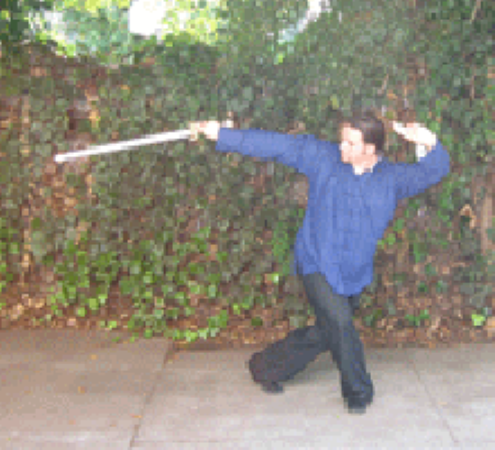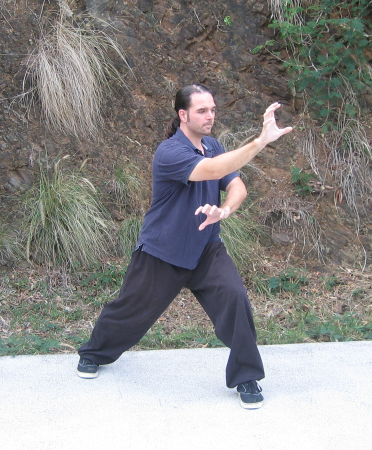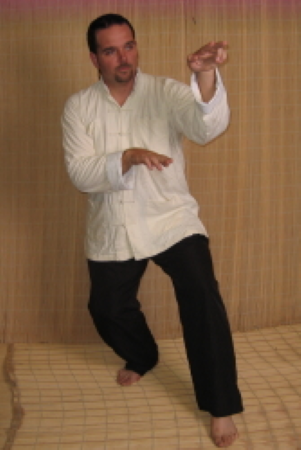Shaolin Kung Fu. When you hear this, certain pictures might flash across your mind.
You might imagine an old monk teaching a small boy in a remote temple, you might smile as you think about the old Shaw Brothers movies that you used to watch on TV, or you might think about athletic monks in bright uniforms flying and flipping across the stage as they put on a spectacular show.

Franklin Fick - Northern Shaolin Sword
These all give a glimpse into what Shaolin Kung Fu is, but they are not the whole picture. Keep reading because this article is going to shed some light on Shaolin Kung Fu.
Shaolin style Kung Fu?
Many people might think that Shaolin Kung Fu is a style of martial arts. This is a common misconception. Shaolin is not a style of martial arts, it is a broad classification that refers to many different styles.
The martial arts of China can be classified into 2 broad categories: Shaolin Styles and Internal Styles. And, there are many styles that fall into each of these categories.
Shaolin styles are usually classified as external styles because they focus on developing strong techniques in the beginning of training. This means that the students focus on developing punches, strikes, kicks, sweeps, and throws.
The Internal styles on the other hand also develop these things, but tend to put a primary emphasis on developing body awareness, coordination, and optimal alignment.
Shaolin styles also develop these things so don't worry if you are interested in studying Shaolin Kung Fu you will still have tremendous awareness, coordination, and proper alignment, you will just develop these attributes by training devastating fighting techniques right from the beginning of your training!
The History of Shaolin
Shaolin is actually the name of a Buddhist temple in China. The name Shaolin translates as small or little forest (probably because the area surrounding the temple contained a young forest). This temple has a long history and is very famous both inside and outside of China.
The root of martial arts at the Shaolin temple can be traced back to an Indian monk, Bodhidharma, who traveled to China to spread the religion of Buddhism. Legend says that after he had an interview at the Imperial Court he retired to the Shaolin Temple and spent 8 years in meditation.
After this time he started to teach the resident monks. He found that the monks at the temple spent too much time focusing on the meditation aspects of Buddhism while neglecting any physical training. Because they had neglected to train their bodies, they were in poor health and therefore could not make much progress in their meditation practice.
To remedy this situation Bodhidharma started to teach the monks some physical training. It is not known what he actually taught the monks, but legend says it was 18 exercises. It is not known if these original movements were martial in nature or if they were just health exercises.
What we can guess is that Bodhidharma being of the priest class of India he would have had some martial training. That combined with the fact that he had made a treacherous journey from India to China were it was common to face hardship and even bandits, he must have had some training in the martial arts to have survived the journey.

Franklin Fick - Southern Shaolin (Ng Ga Kuen) Tiger
Martial Arts Flourish at Shaolin Temple
Over time the Shaolin Temple became famous for its martial arts. That is why today we call the martial arts of China Shaolin. How did this happen?
First temples in ancient China attracted people who were seeking sanctuary and wanted to study religion, but they also attracted people who were fleeing from the law and were looking for a place to hide out. These types of people brought their martial skills into the temple.
Even monks need to protect themselves and their temple from bandits. In fact in ancient China it was common even for villages to hire a martial arts teacher to teach the young people so that the village could defend itself. This gave rise to many different styles, most unknown or died out but sometimes called village styles.
The temple was most likely in a similar situation. they needed to defend themselves. Some of the people already at the temple, who were wanted by the law, were skilled in martial arts. It seems natural that the monks would be interested in survival. The monks also probably realized that kung fu training gives a great workout and might have used the training to keep themselves physically healthy and fit (drawing inspiration from the lessons originally taught by Bodhidharma).
Over the years the temple must have become like a melting pot, absorbing and refining martial movements. And gave birth to many different styles of kung fu.
The temple became so famous for its martial skill that the monks were called upon to help the government fight pirates at one time. And later, the government became so afraid of the martial monks of the temple (think small army), that they had the temple destroyed.
Shaolin Kung Fu Styles
Today we have many different many styles of "Shaolin" Kung Fu and it can be confusing to try to make sense of them all. To make matters worse there are even karate schools that say they teach Shaolin Kung Fu when what they are doing is karate.
If you ask a teacher what style they teach they should not tell you "shaolin kung fu." If they do say that then ask them, "yes, but what style of shaolin?" If they can not answer what style it is they teach then you should run away fast because this person is a charlatan and you should stay away from them.
Anyone teaching kung fu will be able to tell you what style they are teaching. Some popular styles of shaolin are: Long Fist, Preying Mantis (there are several sub-styles like 8 step Preying mantis, 6 harmony, etc), Eagle Claw, Hung gar, Choylifut, etc). Here at Spirit Dragon Institute we teach Five Family Southern Shaolin and Splashing Hands.
Even if the teacher is teaching a less well known style he or she should be able to tell you more about it then that it is just "shaolin." They should be able to tell you the name of the style and perhaps some of the history. And you should be able to find information about most styles of Kung Fu on the internet, so do some homework and find out more about the style if you are interested.
What to expect with Kung Fu Training?
The term Kung Fu doesn't mean martial arts, it actually means skill developed through time and effort. So in Chinese the term kung fu could refer to any skill that takes training to master. But in common usage it refers to the skills of martial arts.
Training in Chinese martial arts requires time and effort to develop skills. To develop a well coordinated and conditioned body that can preform under the stressful conditions of a fight takes time. The training encompasses many aspects but one of the things you will find is that consistent training is the key. You can not expect to take 3 classes and master an art.
You must first go through the basics and learn the forms, applications, conditioning of the system. Most kung fu styles have developed a curriculum of training that takes the novice all the way to very advanced levels. As you go through the training you can not skip steps. Each level takes you further and the next step enhances your skill.
You must also remember that although Kung Fu Training can be challenging, fun, and rewarding, attaining skill in any endeavor takes time and training. You would not expect to become a championship chef or snowboards by taking a week of classes. These things take time and practice. The same holds true for self defense and martial arts.

Franklin Fick - Southern Shaolin (Ng Ga Kuen) Snake
Shaolin Kung Fu Forms
One aspect that makes Chinese Kung Fu unique from other martial arts is the emphasis on forms training. Sure other types of martial arts have forms, but the Chinese styles have elevated forms to the level of art. Chinese forms tend to be longer and more intricate then other forms. The Chinese styles also tend to place a greater emphasis on practicing these forms to develop the body and the fighting techniques of the style.
Compared to other arts- the forms in Chinese Martial Arts are longer and more intricate. The movements are more complex. Often times (depending on the style) the movements oft he forms mimic the movements of the animals. The forms training serves many different purposes.
The Forms are used to train the body and develop coordination and integration so that the entire body can work together to develop power. This is important because the body method in Chinese martial arts is what sets it apart from modern arts like kickboxing and MMA. The Chinese arts have developed training that conditions and allows the practitioner to gain control and use the entire body or specific parts of the body to enhance the power in strikes and blocks. This is what the forms of the system teach.
The forms are fun to practice. Its nice and beneficial to spend time practicing applications and fighting, but the majority of training time in any martial art will be spend in solo or individual training. In modern combative arts the solo training takes the form of conditioning exercises and drills. In traditional Chinese Kung Fu the solo training is the form of the system.
The forms are excellent physical training. But they are more then just conditioning. When you practice a kung fu form you get the conditioning benefit that you would from a workout, but you are also training core movements, techniques, body methods, alignments, and fighting strategies of the system you are studying. So in essence by training a form you are getting a whole range of learning, benefits and conditioning. It is a very smart and efficient method of training.
Shaolin Kung Fu Techniques
What sets Chinese Kung Fu apart from other systems of fighting and what makes the shaolin styles unique? Well we must remember that there are many different shaolin styles and each style might have a different emphasis in regards to fighting strategy, technique, and body method. That being said, there are soem common characteristics that set the Chinese systems apart from other styles.
Chinese kung fu favors circular movement for the most part. Even movements that appear straight are actually circles. The circle is used to absorb, redirect, and block incoming force. The circles continues without stopping to return force or strike the opponent.
There is no 1 and 2 count, or block then strike. Chinese styles like to block and counter in the same movement. In addition Chinese styles tend to favour continuous movement, links attacks and defense in continuous chains to overcome the opponent.
Chinese styles contain all ranges of combat: kicking, striking, locking (controlling the joints), and throwing. Individual styles may emphasize one over the others but usually each one is present to some degree in a traditional system.
Chinese styles don't like to fight straight on to the opponent. They prefer angles and body positions. Even when it looks like the person might be straight on with the opponent, good kung fu uses subtle angles and body position to gain the advantage. This makes it hard3er for the opponent to strike us while giving us the advantage in attacking the opponent.
Secret Kung Fu Training
Many traditional styles have levels of training and not all the training is traditionally taught to the public. Parts of the system that are reserved for dedicated students (sometimes called indoor students or disciples) might not be talked about openly. This might be more many reasons: the material is not suitable for beginners, it might not be suitable for casual or hobby practitioners, the training might be very specialized in developing certain skills like iron body or iron palm, and in ancient times keeping secrets about your skill from the public might have been a factor in keeping yourself alive.
These secret training from the past are also passed down in modern schools, depending on the teacher, what they have learned from their teacher, and depending on the style. For the most part these types of training are not necessary for people seeking health and fitness, and for the most part these types of secret training are not necessary for people seeking self defense skills.
I have found that most authentic teachers not not make a big deal about indoor material or material that is not for the general public. They will teach you if that is the relationship they have with you. They will not hold this type of training over your head like they are dangling a carrot. Authentic teachers just will not talk about these aspects of the system if they have not decided to teach you them, or at the most they will mention them in passing acknowledging that they are part of the system.
In traditional styles you must progress through the system and achieve higher levels of skill. A beginner is not ready to learn advanced training. If the teacher has a well developed curriculum and you must learn one aspect of training before you move on to the next you can be happy that you have found a nicely structured system of training that you can use to advance your skill. If however the teacher mentions secret training only available for those who are "worthy" or makes it into something you must earn with your "devotion" or money, then you have found a teacher that is promoting a cult like atmosphere and it is best to get out of such an abusive situation- even if the teacher has good things that he could teach you (there are other good teachers out there who will foster a relationship that is not manipulative or abusive- you should learn from one of them).
Finding the Right Shaolin Kung Fu School
The first step in finding a kung fu school is to figure out what it is you want to gain from the training. Ask yourself what is it about kung fu that interests you? What is it you hope to achieve or gain? There are no wrong answers to these questions and only you can answer them.
There are many ways to learn kung fu today. You could search your local area and find out what schools are located nearby or you could learn online (like the online training program that we offer). Each scenario has its own strengths and also its own drawbacks.
Learning in a school is great for hands on teaching and being part of a group environment. This is great if you thrive in a social setting, need a structured class environment, and can find a great teacher in your local area who is teaching a style you are interested in. The drawbacks of learning in a class setting is that you are limited by the times that the classes are offered, you share the teachers personal attention with all the other people in the class, and fees for attending classes can be expensive.
Online Kung Fu training is great for people who are interested in learning kung fu but may lack a qualified teacher or classes in their area. It is also great for people who are motivated to study and train, and for people who have the discipline to set their own training schedule and stick with it. Online Kung Fu Training also allows a student to learn at any time is convenient for them and the prices for online instruction are usually much less then what you would pay to attend the instructors classes in person. The drawback of online learning is that you do not get to interact with the instructor in person, but most programs that allow you to learn kung fu online have options for receiving personal feedback and corrections from the instructor through video.
Once you have decided what type of situation is best for you, then it is time to research. Use the internet and see what's around you, what styles and instructors are available in your local area. Also see what styles are available to learn online and research the instructors. If you find something that looks interesting to you, you should research the style more in depth. Visit the schools if they are local or sign up to learn kung fu online.






